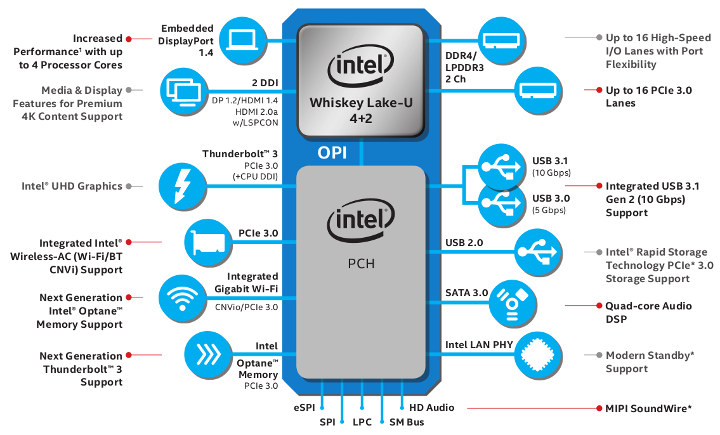We discovered three Intel Amber Lake processors with a 5W TDP through a leak last month namely Core m3-8100Y, Core i5-8200Y, Core i7-8500Y dual core/quad thread processors.
Intel has now made an announcement confirming the launch of Core Y-series (formerly Amber Lake, 5W TDP) and Core U-Series (Whiskey Lake, 15W TDP) 8th generation processors featuring Gigabit WiFi, optional support for LTE and targeting laptop and 2-in-1 hybrids.
Intel Core Y-Series “Amber Lake” Processors
Let’s start with the 5W Core-Y family key features:
- 4MB Smart Cache
- Intel HD Graphics 615
- Intel High Definition Audio with digital surround sound, support for multiple audio streams, jack re-tasking.
- Intel Smart Sound Technology – Dedicated audio Digital Signal Processor designed to process audio for media playback and
voice for PC interactions like Cortana, Nuance Dragon, or Skype. - USB 3.0 – Up to 5x USB 3.0 ports supporting up to 5 Gbps
- USB 2.0 – Up to 6x USB 2.0 ports
- SATA – Up to 2x SATA 6 Gb/s ports
- eSATA – 1x external SATA devices up to 3 Gb/s
- 1x SDXC interface
- PCI Express 3.0 Interface – Up to 12 lanes and 6 ports @ up to 5 GT/s. PCI Express ports can be configured as x1, x2, and x4
- Intel Integrated 10/100/1000 MAC – Support for the Intel I219LM and Intel I219V Gigabit Network Connection
- Display – Up to 3x independent displays supported via
- HDMI 1.4 up to 4096×2304 @ 24 Hz
- DisplayPort up to 3840×2160 @ 60 Hz
- eDP up to 3840×2160 @ 60 Hz
- Low Speed Peripherals – 6x I2C, 3x UART
Three Core-Y “Amber Lake” processors are available as previously reported:
- Core m3-8100Y dual core/quad thread processor @ 1.1 GHz (base) / 3.4 GHz (turbo) – Recommended Price: $281.00
- Core i5-8200Y dual core/quad thread processor @ 1.3 GHz (base) / 3.9 GHz (turbo) – Recommended Price: $291.00
- Core i7-8500Y dual core/quad thread processor @ 1.5 GHz (base) / 4.2 GHz (turbo) – Recommended Price: $393.00
You can find a detailed side-by-side of the three SKUs here. All three processors have the exact same features, and should be pin-to-pin compatible, but the Core i7 model comes with higher CPU and GPU clocks. Note that historically recommended customer prices provided by Intel has not always been accurate, and in many cases are higher that the actual price sold to manufacturers.
Intel Core U-Series “Whiskey Lake” Processors

Intel provided some more details about the 15W Core-U Whiskey Lake processors, but I’ll keep the list short with a comparison against the earlier Kay Lake-R 15W processor.
| FEATURES | KABY LAKE-R U42 (15W) | WHISKEY LAKE U42 (15W) |
| CPU | 14nm CPU / 22nm PCH | 14nm CPU / 14nm PCH |
| GFX | Gen 9 Intel Graphics; up to 24EU | Gen 9 Intel Graphics; up to 24EU |
| Memory | DDR4, LPDDR3, DDR3L | DDR4 up to 2400, LPDDR3 up to 2133 |
| Imaging | 4 Cameras, up to 13MP | None – use USB camera |
| Media,Display, Audio | HDMI1.4/HDCP2.2, DP 1.2 Closed Dual-Core Audio DSP |
HDMI1.4/HDCP2.2, DP 1.2 Quad-Core Audio DSP for high fidelity, low power audio and multi-voice services supported Wake on Voice |
| I/O & Connectivity | Alpine Ridge Thunderbolt Oak Peak WiGig (dual 25×14) |
CNVi (integrated 802.11ac and BT5.0) Integrated USB 3.1 Gen 2 (10 Gbps) Titan Ridge Thunderbolt w/ USB 3.1 & DP1.4 or Alpine Ridge Thunderbolt |
| WWAN | XMM7360 M.2 | XMM 7360 M.2 |
| Storage | Intel Optane SSDs/Memory, PCIe 3.0, SATA, SD 3.0, eMMC 5.0 | Intel Optane SSDs/Memory, PCIe 3.0, SATA, SD 3.0, eMMC 5.14 |
| Security | SGX 1.0, secure biometrics | SGX 1.0, secure biometrics Intel Runtime BIOS Resilience with attestation via Nifty Rock + Intel TXT |
| Manageability | – | Intel Endpoint Management Assistant |
Three Whiskey Lake-U processors have also been launched:
- Intel Core i7-8565U quad core/octa thread processor @ 1.80 / 4.60 GHz with 8 MB SmartCache, Intel UHD Graphics 620; Price: $409.00
- Intel Core i5-8265U quad core/octa thread processor @ 1.60 / 3.90 GHz with 6 MB SmartCache, Intel UHD Graphics 620; Price: $297.00
- Intel Core i3-8145U dual core/quad thread processor @ 2.10 / 3.90 GHz with 4 MB SmartCache, Intel UHD Graphics 620; Price: $281.00
Again if we look at the comparison between the three processors, the parts are basically identical except for the number of cores/threads, cache capacity, and max frequencies.

Jean-Luc started CNX Software in 2010 as a part-time endeavor, before quitting his job as a software engineering manager, and starting to write daily news, and reviews full time later in 2011.
Support CNX Software! Donate via cryptocurrencies, become a Patron on Patreon, or purchase goods on Amazon or Aliexpress




